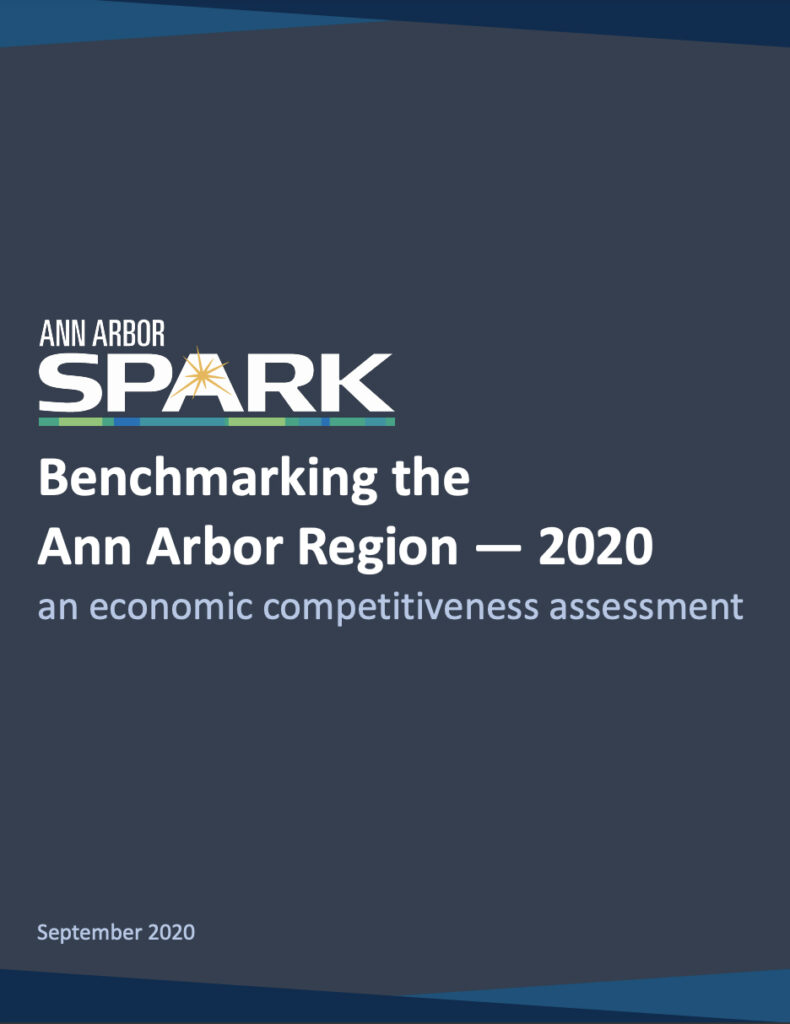
- Key findings show that a majority of rankings either remained static or improved since the 2019 report.
- New for the 2020 report is a section evaluating racial differences, or gaps, in specific metrics across the competitive set.
Ann Arbor SPARK recently released the third iteration of its Benchmarking the Ann Arbor Region report. The purpose of the report is to compare Ann Arbor to regions that are competitive to our region in attracting growing industry companies and in-demand knowledge workers, including Boulder, Colo., Silicon Valley, and Austin, Texas. The report provides clear, unbiased data and a regional analysis for a series of eight metrics:
- University R&D
- Population Movement
- Share of Remote Jobs (new for 2020)
- Venture Capital Activity
- Housing Affordability
- Percent in Poverty and ALICE (replacing Income Inequality from previous reports)
- Driving Industry Employment
- Labor Market
“There’s value in using impartial data to compare our region to similar communities across the country,” said Paul Krutko, Ann Arbor SPARK CEO and president. “It provides an objective assessment of the region’s success, confirms Ann Arbor’s status as a magnet for innovation and talent, and identifies opportunities for improvement.”
Notable Findings
Ann Arbor continues to hold the top spot for University R&D — the amount each university spends on research and development. This metric is a valuable indicator of a region’s inclination for risk taking, proving ideas and adding to the innovation pipeline. Additionally, R&D funding helps to build a conduit of research for future innovations, feeding a region’s entrepreneurial ecosystem.
Across the remaining set of metrics, Ann Arbor ranked:
- Third in population movement, or net migration, up from fifth place in 2018. Washtenaw County is still the most popular destination for movers within Michigan.
- Third for share of remote jobs, a new metric for 2020. The high ranking implies that a lot of existing jobs within Washtenaw County are tech-based and easily done from home, which is in line with the increasing amount of tech-based jobs in Washtenaw County’s economy.
- Third for venture capital activity, up from fourth in 2018. As a result of controlling for population, Ann Arbor continues to rise above the rest.
- Fourth for housing affordability, a significant increase from ninth place in 2018. While there is a perception of Washtenaw County as an expensive housing market, this is a result of comparing it to midwestern and rust belt cities. However, when comparing to Austin, Berkeley, Boulder, and Portland, Ann Arbor is relatively inexpensive.
- Fourth for percent of population in poverty and ALICE. This new metric replaced the previously analyzed income inequality. Paired with other metrics like housing affordability and unemployment, this paints a significantly different picture of the competitive set. Including it in the report is necessary to understand that while many of these regions are listed on “best places” lists and touted as high growth technology economies, these benefits are not enjoyed by everyone.
- Ninth in driving industry employment, a drop from seventh place in 2018.
- Sixth in unemployment, the same as 2018, and 10th in labor force participation, up from 11th in 2018. These key labor market metrics are important for understanding what economic recovery post-COVID will mean for job seekers.
The 2020 report is the first to break down the aggregate data by race in the “Benchmarking the Gap” section. “Aggregate statistics are sometimes useful, but they tend to hide disparities in opportunity,” stated the report’s author Alex West, director of research at Ann Arbor SPARK. “In this section, we attempt to tease out some of the racial differences in three of the metrics — poverty rate, housing affordability and unemployment — and let the data speak for itself.”
A recent presentation by Alex summarizing the 2020 Benchmarking Report is available to watch online.
About the Competitive Sets and Data
Many of the selected regions were chosen due to their inclusion in anecdotal comparisons to the Ann Arbor region. However, where possible, the data have been normalized for population. Most metrics are compared at the county level, some at city, and some at Metropolitan Statistical Area. While the data used in the report was collected before the COVID-19 pandemic, the 2020 analysis will provide an accurate baseline for future benchmarking reports.
About Ann Arbor SPARK
Ann Arbor SPARK, a non-profit organization, is advancing the region by encouraging and supporting business acceleration, attraction and retention. The organization identifies and meets the needs of business at every stage, from startups to large organizations. Ann Arbor SPARK collaborates with business, academic, government, and community investor partners. For more information, please call (734) 761-9317 or visit www.AnnArborUSA.org.
